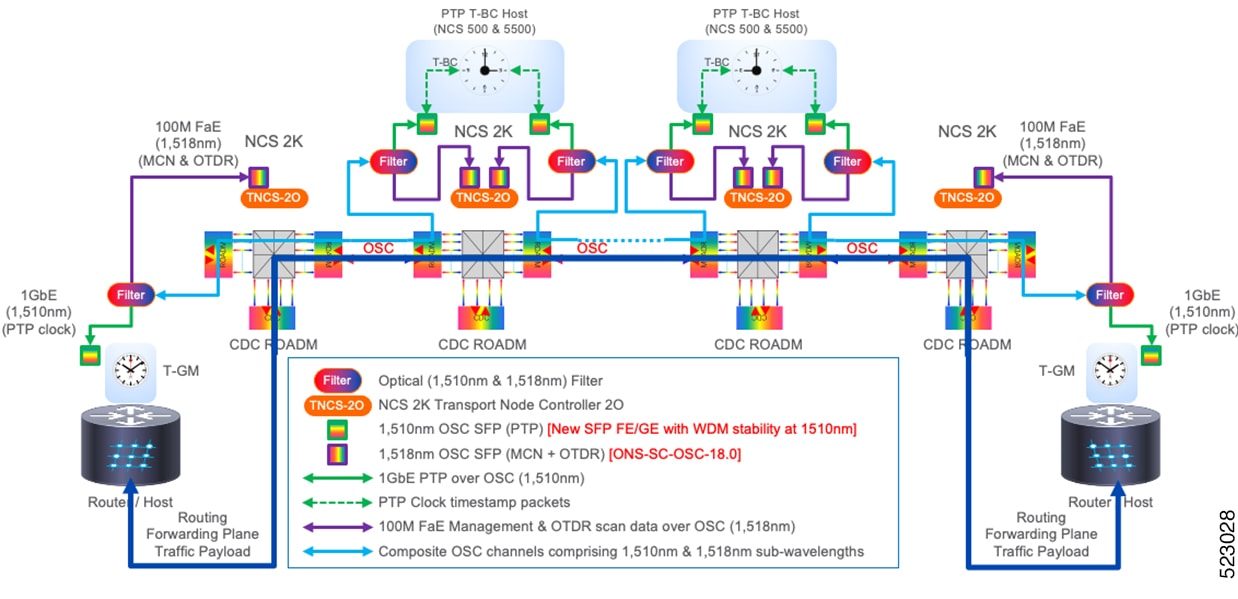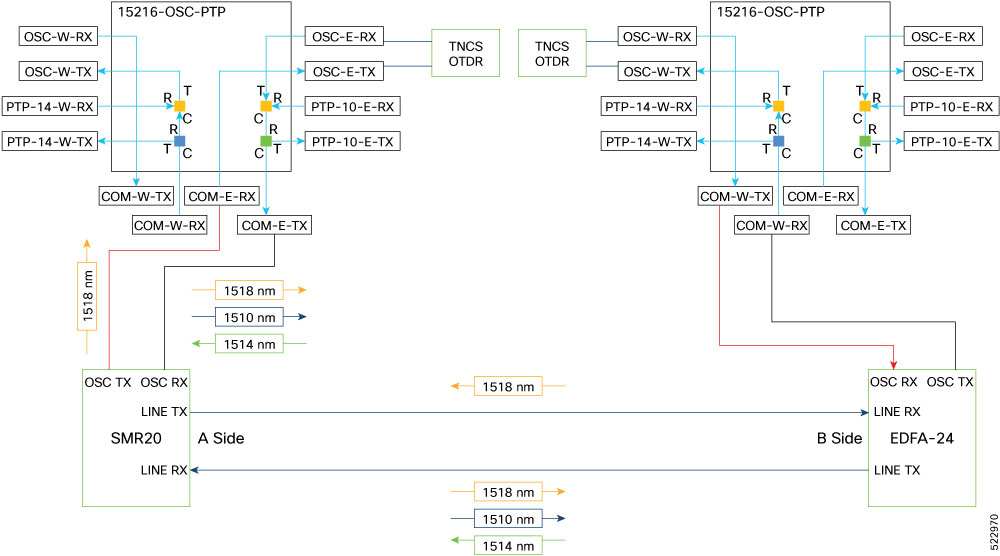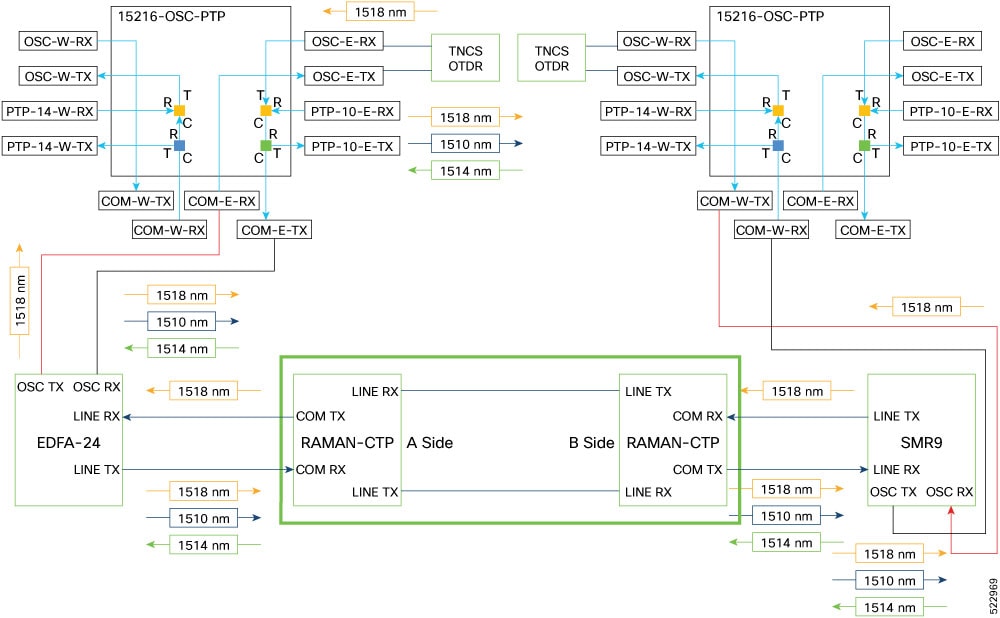Use Case
The PTP solution for NCS 2000 enables leveraging the PTP signals from the NCS 5500 and NCS 540 routers over the NCS 2000 networks.
NCS 2000 Network Configuration for PTP over OSC Link
The PTP solution for the NCS 2000 networks is supported over the following NCS 2000 flex spectrum network configurations.
|
NCS 2000 Flex Spectrum Network |
Components Required |
|---|---|
|
PTP over OSC Link with OTDR |
|
The following table shows the reach of the PTP over OSC link in the NCS 2000 networks with and without RAMAN amplifiers.
|
Signal |
Condition |
Span Reach (dB) |
|
|---|---|---|---|
|
Without RAMAN |
With RAMAN |
||
|
OSC |
1518 nm - FE |
35 |
38 (33 dB at RAMAN startup, 38 dB after RAMAN is ON) |
|
PTP |
1510/1514 nm - FE |
33 |
37 (RAMAN ON) |
|
PTP |
1510/1514 nm - GE |
30 |
37 (RAMAN ON |
 Note |
To limit the RX power below the allowed maximum (–7 dBm) reach, you must use attenuators with PTP SFPs. |
PTP over OSC Link with OTDR using PTP Filter
This solution adds a PTP filter between the TNCS-2O card and the GM clock in the router. The PTP filter multiplexes the PTP signal from the GM clock and the OSC signal from the NCS 2000 TNSC-2O card. The filter sends the combined signal over the NCS 2000 network through the near-end ROADM. The near-end ROADM propagates the signal through its OSC channel to the far end. The combined signal is demultiplexed at the next PTP filter to send the PTP signal to NCS 55xx/540 and the OSC signal to the TNSC-2O card. This sequence of mutliplexing and demultiplexing PTP and OSC signals continue on both sides of the CDC ROADM throughout the NCS 2000 network.

The above image shows the signal flow of the PTP over OSC link using a PTP filter. For more information on the port connection, see PTP Module Port Connections.
Use Case 1: PTP over OSC Link with OTDR, without RAMAN Amplifier
The following hardware is required for this use case:
-
Pluggable optics: ONS-SC-OSC-18.0, ONS-SC-PTP-1514, and ONS-SC-PTP-1510
-
Filter: 15216-OSC-PTP
-
Amplifier: OPT-EDFA-24
-
ROADM Cards: SMR20-FS (NCS2K-20-SMRFS / NCS2K-20-SMRFS-CV / NCS2K-20-SMRFS-L)
The 15216-OSC-PTP filter combines the OSC signal from the TNCS-O card and the PTP signal from the ONS-SC-PTP-1510 pluggable in NCS 55xx in the east direction. The filter sends the combined signal to the OSC RX port of the SMR20 ROADM card through the COM-E-TX port. SMR20-FS sends the combined signal to the line port on EDFA-24 line card on Side B. The EDFA-24 card sends the signal to the COM-W-RX port of the 15216-OSC-PTP filter. The 15216-OSC-PTP filter splits the signal and sends the OSC signal to the TNCS-O card via OSC-W-RX port and the PTP clock signal to the NCS 55xx router.
The following table shows the COM port connections for the PTP Filter Module.
|
Near End |
Far End |
||
|---|---|---|---|
|
From PTP Filter |
To SMR20 |
From EDFA-24 |
To PTP Filter |
|
COM-E-RX |
OSC-TX |
OSC-TX |
COM-W-RX |
|
COM-E-TX |
OSC-RX |
OSC-RX |
COM-W-TX |

Use Case 2: PTP over OSC Link with OTDR, RAMAN Amplifier
The following hardware is required for this use case:
-
Pluggable optics: ONS-SC-OSC-18.0, ONS-SC-PTP-1514, and ONS-SC-PTP-1510
-
Filter: 15216-OSC-PTP
-
Amplifier: OPT-EDFA-24, 15454-M-RAMAN-CTP
-
ROADM: SMR9 (NCS2K-9-SMRxxFS / NCS2K-9-SMRxxFS-L)
The 15216-OSC-PTP filter combines the OSC signal from the TNCS card and the PTP clock signal from the ONS-SC-PTP-1510 pluggable in NCS 55xx in the east direction. The filter sends the combined signal to the OSC RX port of the EDFA-24 (OPT-EDFA-24) amplifier card through the COM-E-TX port. EDFA-24 sends the combined signal via RAMAN-CTP amplifier on Side A and B to the SMR9 ROADM card. The SMR card sends the signal to the COM-W-RX port of the 15216-OSC-PTP filter. The 15216-OSC-PTP filter splits the signal via OSC-W-RX port and sends the PTP signal to boundary clock and the OSC signal to the TNCS card.
The following table shows the COM port connections for the PTP Filter Module.
|
Near End |
Far End |
||
|---|---|---|---|
|
From PTP Filter |
To EDFA-24 |
From SMR9 |
To PTP Filter |
|
COM-E-RX |
OSC-TX |
OSC-TX |
COM-W-RX |
|
COM-E-TX |
OSC-RX |
OSC-RX |
COM-W-TX |

 Feedback
Feedback